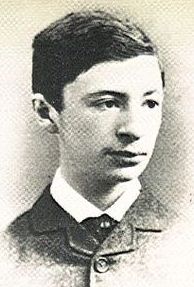Marc-André Raffalovich, 1864-1934
gay French poet, writer
Astrology chart, profile, books, films, links
Libra Ascendant, Virgo Sun, Capricorn Moon, Saturn Rising

AstroData: born 11 September 1864, 09:00 (9am) LMT (-0:09:20), Paris, France. (Sy Scholfield [copyright] quotes birth certificate. RR: AA).
FEATURES: PERSONALIZED PLANETS:
Libra SATURN (conjunct Ascendant; square Moon; semi-sextile Sun), Pisces CHIRON (opposite Sun; sextile Moon), Taurus PLUTO (conjunct South Node; trine Moon; trine Sun).
PATTERNS: GRAND TRINE (Capricorn Moon; Taurus Pluto, Virgo Sun), YOD (Eris-chiron sextile Pluto, all quincunx Mercury), BOOMERANG (Yod plus Neptune), CARDINAL T-SQUARE (Aries Neptune opposite Libra Mercury-Saturn, all square Capricorn Moon), T-SQUARE (Venus opposite Neptune, both square Uranus).
SHAPE: SPLAY.
CHINESE SIGN: WOOD RAT. NUMEROLOGY: "3" LIFEPATH.
Wikipedia Biography [Astrology by Sy Scholfield]:
Marc-André Raffalovich (11 September 1864 – 14 February 1934) was a French poet and writer on homosexuality, best known today for his patronage of the arts and for his lifelong relationship with the poet, John Gray.
Early life
Raffalovich was born into a wealthy Jewish family, which moved from Odessa in the Ukraine to the French capital, Paris, in 1863. His brother, Arthur, became a noted Parisian financier and economist. André went up to study in Oxford in 1882 before settling down in London and opening a salon in the 1890s. Oscar Wilde attended, calling the event a saloon rather than a salon. This is where Raffalovich met the love and companion of his life, John Gray. In 1890, his sister Sophie married the Irish nationalist politician William O'Brien (1852-1928).
Writings
In 1894, Raffalovich started to contribute on the subject of homosexuality (unisexualité, as he called it) to the Archives de l'Anthropologie Criminelle, a prestigious revue founded in Lyon by Alexandre Lacassagne, a pioneer criminologist and professor of forensic medicine. He soon became recognised as an expert in the field, engaging in correspondence with other researchers throughout Europe.
His magnum opus, Uranisme et unisexualité: étude sur différentes manifestations de l'instinct sexuel was published in 1896. In 1897, he started working on Annales de l'unisexualité, and les Chroniques de l'unisexualité with the aim of cataloging everything published on the subject of homosexuality. These have proved useful to historians up to this day.
Conversion
In 1896, under the influence of John Gray, Raffalovich embraced Catholicism and joined the tertiary order of the Dominicans as Brother Sebastian in honour of Saint Sebastian. At the same time Gray was ordained a priest. In 1905, Gray was appointed to the parish of St Patrick in the working class Cowgate area of Edinburgh. Raffalovich followed and settled down nearby, purchasing No. 9, Whitehouse Terrace. He contributed greatly to the cost of St Peter's Church in Morningside, Edinburgh, of which Gray was appointed the first parish priest. In Whitehouse Terrace, Raffalovich established a successful salon. His guests included Henry James, Lady Margaret Sackville, Compton Mackenzie, Max Beerbohm and Herbert Read.
Theories
There is a close link between Raffalovich's views on homosexuality and his Catholic beliefs. He had moved on from the contemporary vision of homosexuality as a "third sex" to consider it simply as an expression of human sexuality. He made the distinction between the born and the chosen inverts. He believed the former worth considering while the latter he thought to be mired in vice and perversion.
Raffalovich drew, however, a difference with heterosexuality based on the idea of vice and virtue. He regarded a heterosexual's destiny as marriage and starting a family, whereas a homosexual's duty, he believed, was to overcome and transcend his desires with artistic pursuits and spiritual - even mystical - friendships.
These views led him to clash with Magnus Hirschfeld and the members of the Scientific Humanitarian Committee, with Raffalovich accusing them of being propagandists for moral dissolution and of wanting to destroy whole generations. He even supported Germany's Paragraph 175 as a way to prevent total moral chaos.
Raffalovich's attempts to reconcile his homosexuality and his Catholic beliefs pushed him further into his criticism of the early gay liberation movement; in 1910, he finally stopped commenting altogether on the subject which had occupied such a place in his life. Instead, he focused on his Edinburgh salon and his support of young artists.
He died in 1934, the same year as his lifelong companion, John Gray.
.... [read more at Wikipedia, the free encyclopedia].
|
|



glbtq encyclopedia

|